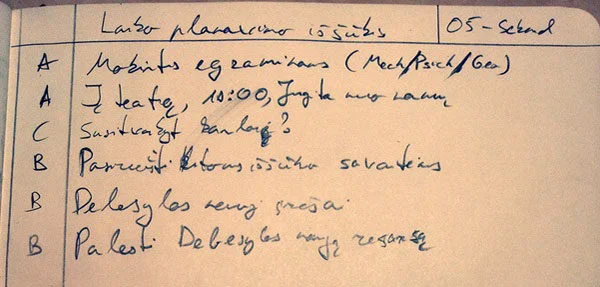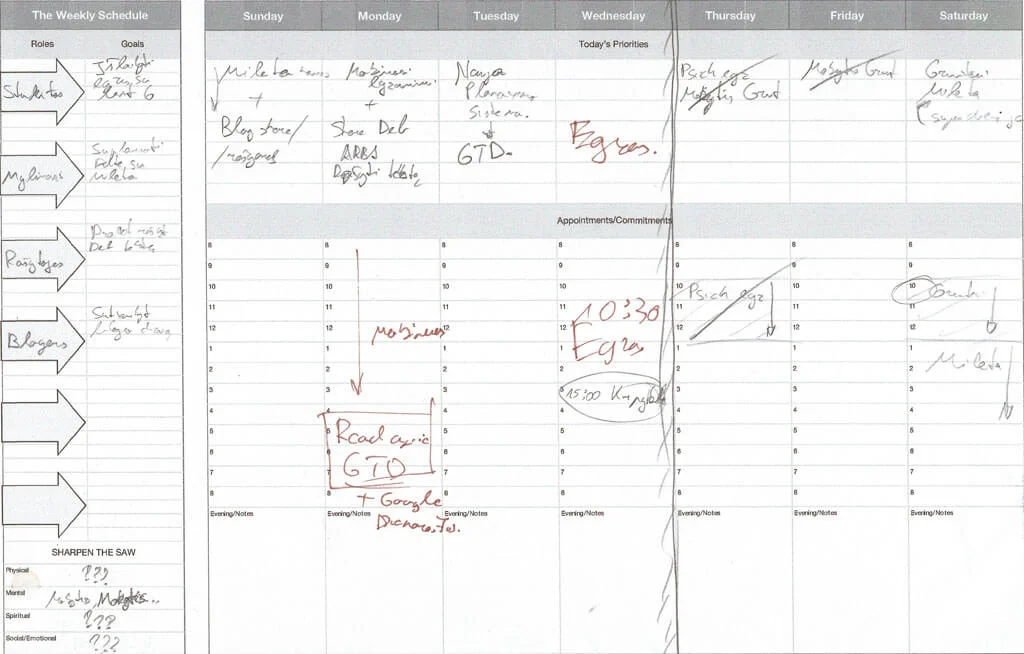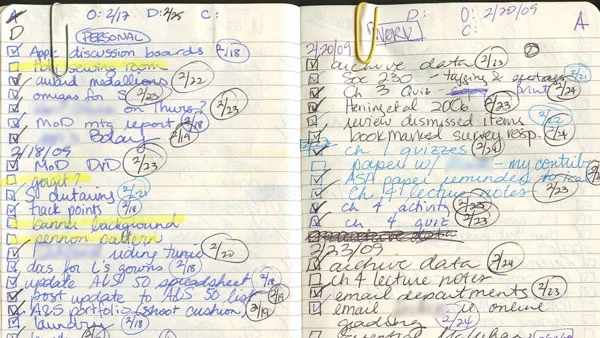It is said that a long time ago, a thousand years ago, in December 2014, such a guy named Daniel was a student. And he was running out of time.
At night he calculated metal structures, drank energy drinks, and during the day he wanted to write a blog. But he didn't get it. Because studies. And work. And the desire to watch another series. And yet... 😴
Daniel decided: During January I will try 6 TIME MANAGEMENT techniques and find one that finally works!
And he did it. Well, that's the story, kids... Good night!
what do you say Want to hear more of the story? Well, let me tell you how Daniel tested 6 time planning methods and how he found one that worked even for him.

"Because if you haven't been able to plan your time until now, it's likely that you've just been planning the wrong way."
Someone smart said it here, but I can't tell the kids that I just made it up myself... Mmm... Literally. Continue reading?
1) For those who want a clear goal: ABC method + Pareto principle
This method will appeal to those who do not want complex systems, but just want a simple method of choosing what to do first and in what order.

I used a notebook and pencil, but computer methods will work as well.
Using the ABC method, all possible jobs are divided into three parts: (A) important and urgent, (B) important and non-urgent and (C) neither important nor urgent.
Then, the work divided according to the Pareto principle is arranged into a more tangible schedule. As this principle states - 80% of work can be done in 20% of time, and the remaining 20% in 80% of time.
In other words, to get rid of most of the work (important and urgent), you should first do the 80% short ones. And in order to reduce the amount of work that might not be worth it, start giving up the remaining 20%. 1
If you are interested, here are more details about these methods:
- My more detailed reviews about a mixture of these two methods.
- When chaos disappears from life - more about the ABC method. 2
- The Pareto rule (20/80) in practice - more about the Pareto principle. 3
2) For those who want to see the process: Kanban
If you often mark your thoughts using arrows or colors - Kanban is for you. This is the most visual system of all six.

I used a mirror, but other smooth, clean surfaces work just as well.
Kanban is based on process (work path) tracking. At one end, the works that have not yet been started are placed, and at the other end, the works that have already been completed. In the middle is everything between these two points. It helps to see how much (and what) work is currently being done and how much has already been done.
Update: I have been using this system for a long time and after the challenge. In fact, it's probably the best system if you have a lot of parallel work that someone needs to take over in between. For example, I write drafts of articles, while other team members edit and design. 4 I'll be back at the end.
If your work is a team, this system will help. 5
You can find more about Kanban here:
- My more detailed reviews about Kanban.
- Personal Kanban 101 – everything you need to know to get started.
- Trello, Kanbanize, Kanban Tool – virtual Kanban boards for those who don't want or can't use a real one. I recommend Trello.
3) For those who want to grow themselves: Weekplan
Do you want to not only keep track of the weekly tasks, but also develop yourself and your skills at the same time? Weekplan will help. It's a system developed by Stephen Covey in his book The 7 Habits of Highly Effective People 6 the author. I'm sure you've heard of this book - it's sometimes cited as one of the best self-help books out there. 7

I used the paper version.
Each of your self-care goals (divided according to your goals at work, family, health, or whatever you want) has a separate place in the weekly plan. These jobs don't go on a long, never-ending list, so they don't get lost as the week goes on.
More about the system and useful links:
- My personal reviews of Weekplan.
- 7 habits of successful people - this book is not necessary to read, but Weekplan is based on it.
- Weekplan – an app in the browser and on your smartphone.
- Computer template – for those who would prefer to use Excel, Google sheets or a similar program.
4) For one with many thoughts: Getting Things Done
Although it is one of the more complex systems (the most complex of those mentioned here), it does its job wonderfully. So amazing that in the system's home state of the United States, it has become almost a religion among principals and other executives.

This is the bowl into which I put all the thoughts that came into my head.
The system solves one of the main productivity problems: the human brain doesn't work as well when it's busy with questions about what to do next. 8
GTD solves this problem through a simple process:
- Collection - all works and information are "thrown out" from active thoughts to a temporary storage place (see a possible option in the photo). 9
- Sorting - all tasks that can be done in 2 minutes are done at once, tasks that do not have a defined goal or solution are put in the "idea vault", and everything else is scheduled for the week. 10
- Sorting again - repeated once a day and once a week.
More about the GTD system:
- My broader assessment of GTD - a more detailed version of this description with illustrations.
- Getting Things Done - the book of the author of the system. 11
- Toodledo - one of the possible GTD applications for your convenience.
5) For those who want to have the freedom to choose: Final Version
Imagine - what if you could choose what to do next just by listening to your desires in the moment and still manage to finish things on time? Final version 12 helps achieve just that.

These aren't my notes, but mine looked very similar.
The principle is simple: write all your work in one long list, and then write it and look at all the points in order. When you come across one you'd like to cross off (such as replying to emails), mark it with a dot. Then go find another job you want to do BEFORE the first one, like "call mom." 13 Repeat this review until you can no longer find the jobs you want to do first.
After choosing the tasks (usually there will be about 3-4 of them), complete them to the end. When finished, remove the tasks from the list and repeat the process.
This system thus gains two advantages:
- All the tasks on your list become equally important, so you don't stop somewhere at the top of the list with the most difficult tasks. 14
- By choosing the sequence of work yourself according to any whims, there is no longer any desire to postpone work. 15
There is a third advantage - urgent tasks are obviously completed more quickly. But read more about it here:
- Introduction to Final Version - a broader introduction to the use of the system and its advantages. 16
- "Do it Tomorrow", Get Everything Done - the books of Mark Forster, the author of the system, on which Final Version is based.
6) For someone who doesn't want to plan time: Without the system
If you don't want (or need) to plan your time, it's better not to bother. Countless people have lived and still live without planning their days. Live happily even without being very efficient.
Because what's the point of efficiency if it kills your creativity or doesn't make you happy? Maybe you are a person having little work. Or have just one. maybe you like my mom making handmade dolls, longing to live peacefully, enjoying the moments and the garden that changes throughout the year. 17
You don't need a productivity system if you have nothing to do with it.
And there is nothing wrong with that.
So I have two questions:
- And how do YOU plan your time?
- ...And if you don't plan anything - which of these methods will you try today?
Please share your answer!

Throwing away these useless works will help you river philosophy.↩
By the way, I also recommend the rest of Iveta's blog. Despite being a bit dead, some of her lyrics are really cool.↩
Cool and Paul's blog. Not very detailed, but there is something to read.↩
Alone with all my projects and ideas, I could hardly turn around. That's why I hire editors and designers I trust.↩
To some purpose Kanban was developed specifically in the Toyota factory. Toyota has been one of the most powerful car manufacturers in the world for more than half a century precisely because of the application of this system.
Additionally: This system, as he gave it to me, is also used by Alex Monaco in his design projects company. He often praises Trello.↩
Published in Lithuanian in 2014 by Mijalba publishing house, in the original language The 7 Habits of Highly Effective People, first edition in 1989.↩
Although I personally would rate it only 3 clouds out of 5.↩
Have you noticed that some of your best ideas come in the shower, sitting on the bus without your phone in your hands or, sometimes funny, during sex? Namely - we are most creative in moments of "Laziness".. I am also talking about this "The Lazy Manifesto".↩
Other possible places can be mentioned earlier Trello, used by me OneNote, popular Evernote or simply the praises of such a Virsmai(.lt) author, Martynas paper notebooks.↩
Anyway, what I noticed during my creative years - the best don't plan more than a week ahead. Too much can change during this time. About the benefits of not planning and in the books how Don't Work by Jason Fried, which you can also read my written review.↩
There is also Lithuanian translation, but this edition was rife with translation errors and illustration inconsistencies. I recommend this condensed version in English.↩
Yes, that's the official name…↩
Because that is perhaps more important.↩
Which you may not need to do at all...↩
Just like I learned during the early rising challenge. If you often procrastinate, I recommend reading this story.↩
The author of the system is one of those authors who value information, not its appearance, so here is his full blog. It can be difficult to find, but when you find it, you will be happy. 🙂↩
By the way, this peaceful garden is why I settled in my parents' neighborhood. There is no fence left between our plots and I spend the spring under the apple trees planted by my grandparents.↩
I myself follow a method similar to Final Version, but I have noticed quite frequent postponement of work. While reading the article, I realized that I plan too many very different tasks for one day. Either way, there's no better feeling than putting a plus on a job/point done.
Ah, it's really fun to cross off work! 😀 Then I think it's probably best to divide them into small parts? 🙂
Oh yes, as a child, I need the fastest possible result, so I try to divide the work into the smallest possible stages. Because when you keep doing and there's no end in sight, you don't give up. I want to put that plus, more precisely, I cross it in red so that I can see it clearly 🙂 For this I use the simplest cork board with a wooden frame on which I attach the work of the week. At first, I hung the most important ones of the month, but there was too much black and I did most of them in the last week, so now it is easier, although sometimes I know that I will do it next week, but I can really feel the progress.
Thank you Monica!! Sounds interesting 🙂
There is another unusual way, maybe more of writing down so you don't forget. There are calendar books, one corner of the pages of which is made in such a way that you can easily tear it off and write down what work you do or have to do that day. For example To call about something. You cross out all the work you do, and you put a check mark next to the started and incomplete ones, and when there are no more unfinished works, you tear off that corner. This way you can perfectly see how much and on what day there are unfinished works, because you can easily find where there is an untorn corner 🙂
Thanks, Aurimas, a good reason to buy such calendars then. I completely forgot that they really are like that 🙂
you've been lazy all your life and don't know how to pass the time.... perfect article makes you set yourself some tasks and get over everything well..
Thank you, interesting plans and proposals, I choose the paper version hanging in front of my eyes.
Great and detailed info. Exactly what I was looking for. thank you
What a great website, I just found it by googling 'time management techniques'.
I am a single mother with a full-time job; my daughter attends 2 clubs, I don't have any physical help at home or in my life :)
I used to do 6 buda all the time, somehow, it's the most comfortable for me... But I'll definitely try 2, and I'm thinking about the bowl as well. I have many thoughts and ideas in my head; sign up really works.
Thanks for sharing, valuable information!
by the way, God's Word talks a lot about time. Mostly, that 'time is short' and that you don't know when the time will end.... http://www.charity.lt/biblija/temos/laikas
By the way, I'm very grateful, I found it by accident, and it's written in such a simple way, it's great.
Thank you.